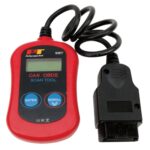Connecting an OBDII scanner to a Nissan Xterra can sometimes be problematic. This article explores a peculiar issue where the scanner only connects when the voltage at the OBDII port drops to a specific range, around 11.84v. We’ll delve into the symptoms, potential causes, and possible solutions for this frustrating problem to help you get your Xterra diagnosed and repaired.
Understanding the Voltage-Dependent Connection
A common issue encountered when attempting to perform an OBDII Nissan Xterra repair is difficulty establishing a connection with a generic OBDII scanner. In a specific scenario, the scanner consistently connected only when the voltage at the OBDII port (measured between pin 16 and pin 4) was around 11.84v. This voltage level was achievable with the engine off and by applying a load to the electrical system, such as pressing the brake pedal and turning on the headlights.
With the ignition on, engine off, the voltage typically read between 11.8v and 11.84v, allowing for a successful scanner connection. However, after starting and then stopping the engine, the voltage would rise above 12v, preventing the scanner from linking. Interestingly, a professional-grade Snap-on scanner could connect by manually entering vehicle information, bypassing the generic OBDII protocol. This confirmed the ECU itself was functioning correctly.
Further testing revealed that it wasn’t the brake pedal itself, but the resulting voltage drop caused by the increased electrical load that enabled the scanner connection. With the engine running and the alternator charging, the voltage at the OBDII port measured between 14.2v and 14.4v, and the scanner consistently failed to connect. This behavior points to a possible voltage sensitivity within the ECU’s OBDII communication circuitry.
Potential Causes and Solutions
The core issue appears to be the narrow voltage range within which the generic OBDII scanner can communicate with the Xterra’s ECU. Why the system behaves this way remains a question. One hypothesis is that the ECU might have an internal voltage regulator that limits the power to the OBDII port for protective purposes. This regulator could malfunction or be overly sensitive, preventing communication outside the specific voltage range.
Several potential solutions could be explored:
- Check for loose ground connections: A poor ground connection could contribute to voltage fluctuations and hinder communication. Thoroughly inspecting and cleaning all ground connections related to the ECU and OBDII system is recommended.
- Inspect the OBDII port and connector: Damage to the port or connector pins can disrupt communication. Carefully examine both for any signs of bending, corrosion, or debris.
- Test with a different OBDII scanner: While a professional scanner worked, trying a different generic scanner could rule out a compatibility issue with the specific scanner being used.
- Consult a qualified Nissan technician: A technician with access to Nissan-specific diagnostic tools and service information can pinpoint the problem and recommend the appropriate repair. This is especially crucial for passing emissions tests, which require the engine to be running.
Conclusion: Addressing OBDII Communication Problems in Your Nissan Xterra
Troubleshooting OBDII connection issues in a Nissan Xterra requires a systematic approach. Understanding the relationship between voltage and scanner connectivity is crucial in this particular scenario. While the exact cause remains unclear, exploring potential solutions like checking ground connections, inspecting the OBDII port, trying different scanners, and consulting a qualified technician can help resolve the problem and allow for proper diagnosis and repair. Don’t let a finicky OBDII connection prevent you from maintaining your Xterra.

